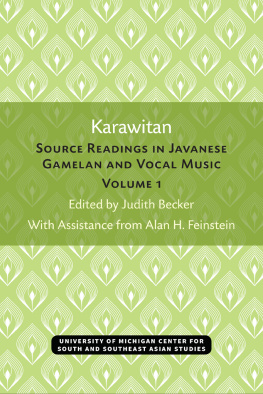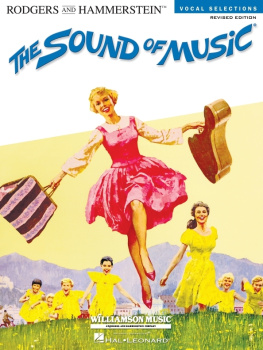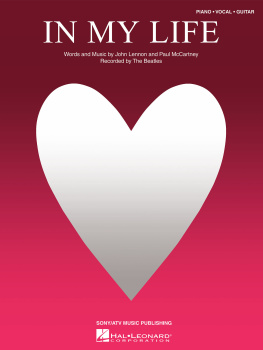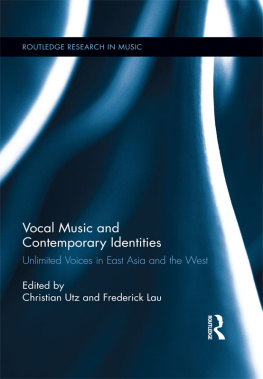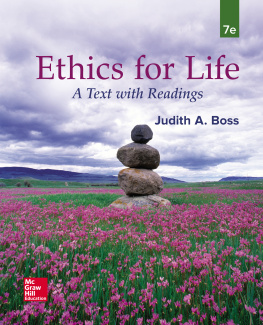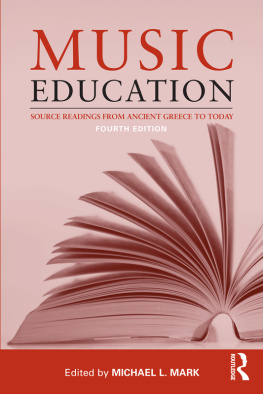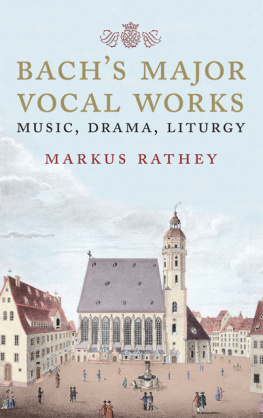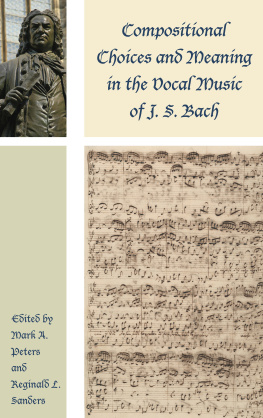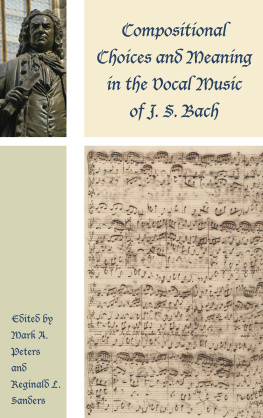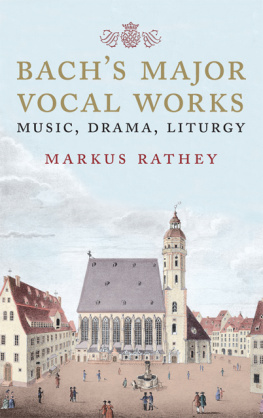Judith Becker - Karawitan Source Readings in Javanese Gamelan and Vocal Music: Volume 1
Here you can read online Judith Becker - Karawitan Source Readings in Javanese Gamelan and Vocal Music: Volume 1 full text of the book (entire story) in english for free. Download pdf and epub, get meaning, cover and reviews about this ebook. year: 2020, publisher: University of Michigan Center for South and Southeast Asian Studies, genre: Children. Description of the work, (preface) as well as reviews are available. Best literature library LitArk.com created for fans of good reading and offers a wide selection of genres:
Romance novel
Science fiction
Adventure
Detective
Science
History
Home and family
Prose
Art
Politics
Computer
Non-fiction
Religion
Business
Children
Humor
Choose a favorite category and find really read worthwhile books. Enjoy immersion in the world of imagination, feel the emotions of the characters or learn something new for yourself, make an fascinating discovery.
- Book:Karawitan Source Readings in Javanese Gamelan and Vocal Music: Volume 1
- Author:
- Publisher:University of Michigan Center for South and Southeast Asian Studies
- Genre:
- Year:2020
- Rating:5 / 5
- Favourites:Add to favourites
- Your mark:
- 100
- 1
- 2
- 3
- 4
- 5
Karawitan Source Readings in Javanese Gamelan and Vocal Music: Volume 1: summary, description and annotation
We offer to read an annotation, description, summary or preface (depends on what the author of the book "Karawitan Source Readings in Javanese Gamelan and Vocal Music: Volume 1" wrote himself). If you haven't found the necessary information about the book — write in the comments, we will try to find it.
Judith Becker: author's other books
Who wrote Karawitan Source Readings in Javanese Gamelan and Vocal Music: Volume 1? Find out the surname, the name of the author of the book and a list of all author's works by series.
Karawitan Source Readings in Javanese Gamelan and Vocal Music: Volume 1 — read online for free the complete book (whole text) full work
Below is the text of the book, divided by pages. System saving the place of the last page read, allows you to conveniently read the book "Karawitan Source Readings in Javanese Gamelan and Vocal Music: Volume 1" online for free, without having to search again every time where you left off. Put a bookmark, and you can go to the page where you finished reading at any time.
Font size:
Interval:
Bookmark:

THE UNIVERSITY OF MICHIGAN CENTER FOR SOUTH AND SOUTHEAST ASIAN STUDIES
MICHIGAN PAPERS ON SOUTH AND SOUTHEAST ASIA
Editorial Board
Alton L. Becker
Karl L, Hutterer
John K. Musgrave
Peter E. Hook, Chairman
Ann Arbor, Michigan
USA
KARAWITAN
SOURCE READINGS IN JAVANESE GAMELAN AND VOCAL MUSIC
Judith Becker
editor
Alan H. Feinstein
assistant editor
Hardjo Susilo
Sumarsam
A. L. Becker
consultants
Volume 1
MICHIGAN PAPERS ON SOUTH AND SOUTHEAST ASIA
Center for South and Southeast Asian Studies
The University of Michigan
Number 23, 1984
Open access edition funded by the National Endowment for the Humanities/Andrew W. Mellon Foundation Humanities Open Book Program.
Library of Congress Catalog Card Number: 82-72445
ISBN 0-89148-027-7
Copyright
1984
by
Center for South and Southeast Asian Studies
The University of Michigan
Publication of this book was assisted in part by a grant fromthe Publications Program of the National Endowment for the Humanities. Additional funding was provided by the National Endowment for the Humanities (Translations); the Southeast Asia Regional Council, Association for Asian Studies; The Rackham School of Graduate Studies, The University of Michigan; and the School of Music, The University of Michigan.
Printed in the United States of America
ISBN 978-0-89148-027-3 (hardcover)
ISBN 978-0-472-03818-3 (paper)
ISBN 978-0-472-12768-9 (ebook)
ISBN 978-0-472-90164-7 (open access)
The text of this book is licensed under a Creative Commons Attribution-NonCommercial-NoDerivatives 4.0 International License: https://creativecommons.org/licenses/by-nc-nd/4.0/
CONTENTS
This work is complete in three volumes.
Volume 1
Articles and monographs by Martopangrawit, Sumarsam, Sastrapustaka, Gitosaprodjo, Sindoesawarno, Poerbapangrawit, and Probohardjono.
Volume 2
Articles and monographs by Warsodiningrat, Sumarsam, Gitosaprodjo, Purbodiningrat, Poerbatjaraka, Sindoesawarno, and Paku Buwana X.
Volume 3
Appendix 1: Glossary and index of technical terms mentioned in the texts. Appendix 2: Javanese cipher notation (titilaias kepatihan) of musical pieces mentioned in the texts. Appendix 3: Bibliographies of authors. Bibliography of sources mentioned by authors, translators, editors, and consultants.
For information on obtaining the original versions of these translated texts, write
Center for South and Southeast Asian Studies
Publications
130 Lane Hall
The University of Michigan
Ann Arbor, Michigan 48109
USA
Judith Becker
The last millenium of Javanese civilization was a period of prolific literary activity. In his three-volume annotated catalogue of Javanese literature from 900 to 1900 A.D., Pigeaud has included tens of thousands of entries grouped under four general categories: Religion and Ethics; History and Mythology; Belles Lettres; and the final potpourri category, Science, Arts, Humanities, Law, Folklore, Customs, and Miscellanea. Many of these texts were written in Javanese poetic meters and were intended to be recited, chanted, or sung aloud, for oneself or for an audience. While references to music, to gamelan, to dance, and to song are frequent, texts dealing specifically with the history or craft of music are rare. The most famous of the references to music, from the nineteenth-century manuscripts Panji Semirang, Sastra Miruda, Pustaka Raja, and Serat Centhini, are discussed in volumes 1 and 2 (Poerbatjaraka, Warsodiningrat, Martopangrawit, Sindoesawarno). With the exception of the aforementioned, if an old manuscript includes a section about music, it will most likely give only the titles of gendhing appropriate to accompany particular scenes in a wagang performance (Pigeaud 1967[2]:51, 80, 417, 690). Writing whole treatises exclusively about gamelan, dance, or tembang is a twentiethcentury phenomenon which seems to have been stimulated by the interest of Dutch scholars and more recently by the establishment of Western-style conservatories of music. Books, articles, and manuscripts about karawitan are now plentiful and have become a necessary adjunct study for the Western student of the gamelan tradition. The texts included here were written over a forty-five-year time span (ca. 1930-1975) and were selected by the editor and translators from articles and manuscripts to which we had access during the period 1969-1978.
The men who wrote these texts were well acquainted with the long Javanese tradition of historical, literary, and didactic scholarship in which certain kinds of questions are asked and certain other kinds of questions are not asked. The particular assumptions of their literary tradition mold the ways in which they think, talk, and write about music.
We, the translators, come from a different scholarly tradition with our own presuppositions and criteria of evaluation. The authors subjectivities are translated and filtered through our own subjectivities, resulting in a body of texts which cannot presume to be objective. We are presenting interpretive scholarship: our interpretations of the interpretations of our authors about gamelan music.
In preparing these.manuscripts for an English-speaking, primarily Western, late-twentieth-century audience, we are removing them from their context, from the intentionality and language of their authors. In so doing, we have broken their moorings from the psychology of their authors (Ricoeur 1971:534). But these are old problems, well known to generations of literary critics and translators, which nonetheless continually reveal new facets and new solutions to those undeterred by the awesomeness of the undertaking.
In like manner, we have not hesitated to pursue this utopian task with high enthusiasm and strong confidence in the worthiness of our effort. We have severed the ties of these manuscripts to a particular time and place, enlarging their horizons to include an international scholarly community.
The essential vocation of interpretive anthropology [musicology] is not to answer our deepest questions, but to make available to us answers that others... have given, and thus include them in the consultable record of what man has said. (Geertz 1973:30)
The consultable record of what man has said often needs to include more than simply the text in focus. A discussion of the manner of the saying, the intention of the author, and the tradition within which he wrote can help to bridge the ravine between distant texts and their readers (Becker, A. L. 1979:211-43). These authors did not all have the same audience in mind, nor did they write at the same time, but in one respect they are similar; they share a particular attitude toward the writing of a text, a presupposition about scholarship itself. The texts are not original in the sense that their authors are putting forth ideas and interpretations that are unique or lacking roots in traditional thought. Rather, it is accumulated wisdom that is presented here, the scholarly aspects of karawitan (the combined vocal and instrumental music of the gamelan), which have been preserved and transmitted primarily as oral tradition, but also through manuscripts. Java, until the twentieth century, belonged to a chirographic tradition, that is, a manuscript tradition with its own noetics, or the system of shaping, storing, retrieving, and transmitting knowledge (Ong 1977:96). Many of the authors of these texts cite earlier manuscripts, many refer to the teachings and writings of other scholars, and nearly all, at one point or another, pay homage to the ancestors from whom they received the gamelan tradition. The author of a traditional Javanese text is often rewriting a previous text or texts. Sometimes an author will cite his sources (see Sulaiman Gitosaprodjo in this volume); more often they need not be mentioned. It is expected that readers will share the scholarly assumptions of the authors. A comparison of the texts,
Font size:
Interval:
Bookmark:
Similar books «Karawitan Source Readings in Javanese Gamelan and Vocal Music: Volume 1»
Look at similar books to Karawitan Source Readings in Javanese Gamelan and Vocal Music: Volume 1. We have selected literature similar in name and meaning in the hope of providing readers with more options to find new, interesting, not yet read works.
Discussion, reviews of the book Karawitan Source Readings in Javanese Gamelan and Vocal Music: Volume 1 and just readers' own opinions. Leave your comments, write what you think about the work, its meaning or the main characters. Specify what exactly you liked and what you didn't like, and why you think so.

